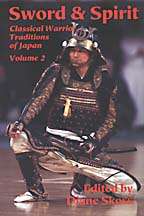This book is due out Feb 11, 1999 and I would recommend that anyone interested in the classical weapons arts of Japan pre-order a copy. At the price it’s good value for money. Those who bought volume one of this series will be familiar with the format, a set of articles, interviews and short notes. Once again there should be something for everyone here.
The book started a bit slowly for me, with an introduction by the ubiquitous Dave Lowry and a translation of the Kyujukyu Kakun or 99 precepts of the Takeda Clan. This is another in a seemingly endless line of lists of rules from the Japanese warlords in their apparently futile efforts to encourage their underlings to make nice with each other and quit betraying their boss to the enemy every time they went into a battle.
#82 “When issuing orders to retainers during bad weather, be compassionate.”
#32 “A retainer should not feel disgruntled about his master’s coldness toward him, no matter how unreasonable it may seem.”
If the Japanese economy were better you might see this one on the management theory shelves beside the Go Rin no Sho. It certainly has a better claim to the placement.
In the second article Alexander Bennett provides a background and analysis of the Takeda Clan and the Koyo Gunkan, a compilation of lore about the Takeda, from which the 99 precepts is taken. Bennett illustrates the importance of this document in the formation of the early Tokugawa era “Bushido” ideals, and its influence on later works of this genre such as the Budo Shoshinshu, and the Hagakure.
I was pleased to see that Diane and Meik Skoss did what I asked them in my review of the first volume, and added more to their “field guide to the classical Japanese martial arts”. This volume they describe Yoshin-ryu, Toda-ha Buko-ryu, Tenshinsho-den Katori Shinto-ryu, Tatsumi-ryu, Takenouchi-ryu, Shojitsu Kenri Kataichi-ryu, Shinto Muso-ryu, Sekiguchi Shinshin-ryu, Negishi- ryu, and, puff puff, Hozoin-ryu Takada-ha. Quite a list.
Meik Skoss follows this with an interview of Saito Satoshi, the headmaster of the Negishi-ryu Shurikenjutsu school. Saito makes comments on modern sport budo, the transition from one headmaster to another, the role of freestyle practice in budo, and several other topics of continuing interest to modern martial art students. He also gives up a juicy big secret teaching of Shurikenjutsu which I am not going to reveal here. Go buy the book. These interviews are of immense value to the budo student in the west for many reasons, not least of which is to reveal what kind of a person is the head of a style. Your local streetcorner grandmaster might do well to read these interviews and learn a bit about real life. And so might some of us “knowledgeable budo writers” too, now that I think about it.
The next three articles, which together constitute about half the book, are all interrelated. Each, by itself, is worth the price of admission. Liam Keeley makes some absolutely vivid points about what a technique ought to be if it is to be effective. K.I.S.S. Keep it Short and Simple (well that’s how he puts it.) Keeley uses the relationship of “iaijutsu” and “kenjutsu” practice (solo and partner kata), to illustrate his points. He then uses the iai practice of the Tatsumi-ryu to further refine the argument.
This is the kind of writing that I can hardly resist getting my teeth into and chewing away at. Keeley writes clearly and well, and makes some provocative statements that have my fingers itching to respond but I will refrain here for the sake of space. I’ll be reading this one again and perhaps one day I’ll get the urge to analyse it. Needless to say I enjoyed it.
The next article was one I enjoyed when it appeared in the Journal of Asian Martial Arts, but it fits damned well right here. Karl Friday seems to expand on Keeley’s article with an analysis of kata and pattern practice in the koryu bugei. It’s a fine outline of the topic and a careful reading would answer a lot of questions about “how come us sword guys study such as useless thing when we could be learning real self defence down the street”. I was pleased to have a chance to re-read it.
Finally, to stretch the analysis yet a step further, Nishioka Tsuneo describes the role of uchidachi and shidachi in partner practice.
Congratulations to Diane for a masterful bit of editing in this latest volume. All us wannabe samurai should read this one carefully at least a couple of times.
Kim Taylor
Editor, Journal of Japanese Sword Arts, February 1999
Is that another great cover, or what? Knowing that one shouldn’t pronounce judgement — even a positive one — solely on the basis of a book’s cover, I handed off these companion volumes to a friend who’s considerably more of an Oriental cognoscenti than myself during a holiday get-together. He sat absorbed on the couch for a good half-hour ignoring the social conversation, and came out of his trance to say simply, “Good books.” As I surmised and he confirmed, this “Classical Warrior” series presents just enough information to be thorough and engaging while not becoming encyclopaedically dull.
D. Patrick Miller
Fearless Reviews, January 30, 1999

